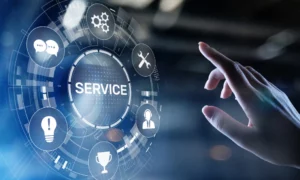With statistics that estimate the IT market to be worth beyond $5 trillion, each innovation and every update becomes major IT tech news.
It is reasonably understandable that with the depth of penetration information technology has in our daily lives, each little improvement or change is a major turning point.
Here is a small list of the top 6 information technology trends that are reshaping the industry
Edge Computing
The modern society is hungry not only for data and processed information, but how fast it is delivered to us. While as individuals, we might take a few minutes of delay for granted, it is pretty different for corporations and organizations. For them, a few milliseconds can make all the difference between winning or lagging behind.
In edge computing, there is no central server. Much like cloud computing, data is stored on offsite servers. But this time, IoT and high-speed internet like 5G and fiber optics help in processing the data online, but physically as close to the user as possible.
This gives the best of both worlds: cloud computing storage of data for multiple backups and retrieval, yet close to the user so there is minimum delay in processing and transmission.
Cybersecurity Mesh
A relatively new concept that is nascent and may require heavy investment and development, cybersecurity mesh is showing promises.
The cybersecurity market is huge: $156.3 million. Digital security is increasingly becoming tough to ensure as online thievery and scams become ever more complex. The stakes are high in the cybersecurity game. It is not only digital forms of money that bad actors can siphon away, but valuable data that they can then sell in different black markets.
Traditional forms of security such as firewalls, encryption and other barriers are becoming ineffective over time. More and more sophisticated attacks are being designed, even as we speak.
One novel way to address this is through mesh security. Rather than have a single layer of security,
mesh security uses multiple layers, one for each node that may be exposed. For bad actors, this means that to access the complete set of data, they will need to penetrate each layer independently.
While not completely secure, mesh security can help limit data breaches, drastically reducing loss of sensitive assets.
Software as a Service
If you keep up with information technology news, you may have heard Software as a Service (SaaS) terms frequently.
The concept is simple and has been implemented for years now. At its core, SaaS is organizations simply outsourcing their software side to dedicated software houses, who specialize in the respective ware.
This frees the former from maintaining an infrastructure to run the software, including human resources. On the other hand, with the SaaS providers being expert in their field, they can offer much more efficient and better software compared to an in-house built one.
The former organizations simply pay for a subscription and enjoy the digital capabilities offered to them.
Internet of Behavior
The technology information systems have developed to a great extent. You may have heard of the Internet of Things (IoT), where different online devices – ranging from mobile phones to CCTVs to sensors – can collect data.
This treasure trove of data can be then processed under different algorithms to make sense and information.
But the Internet of Behavior (IoB) takes this to another level. The data generated by IoT is analyzed against humans to create predictions on which actions can influence employees.
However, there are several roadblocks to IoB. The thought of your data being collected to make a psychological profile of you and then taking steps to manipulate seems to be digital fascism. Unless the industry comes up with regulations that can define the extent of what employers and service providers can do with IoB, this trend may not rise at all.
Privacy Enhanced Computing
Internet privacy is a very touchy subject. With the vast amount of data generated – including individuals – organizations are sitting on top of a treasure that they are always eager to use to their advantage.
However, with the public getting more informed and data privacy regulations such as EU’s GDPR limiting them, they are finding it difficult to use the data.
Privacy enhanced computing is the next step where users can generate the data they usually do, but companies do not have access to specific personal information.
This compromise means that individuals are secure and satisfied with no privacy breaches, while firms get the information they need.
CIO Roles To Broaden
CIO, or Chief Information Officers, are primarily responsible to ensure the IT side of any organization runs smoothly.
However, their roles are quickly evolving and are frequently finding themselves holding up the cybersecurity end too.
On top of that, with the quick pace the information technology is evolving, they have to keep themselves increasingly updated with the latest innovations. In fact, all above of the previous trends are somehow entering in their domain of operations too.
In the future, CIOs will be more than just running the digital aspects of an organization, they will be central in all things online.



































